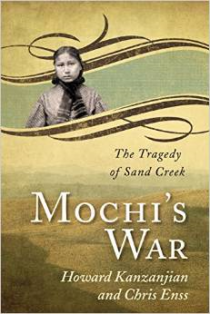Enter now to win a copy of
Mochi’s War: The Tragedy of Sand Creek

“Mochi was so distinguished for fiend-like fierceness and atrocity that it was not deemed safe to leave her on the plains. She was a fine-looking Indian woman but as mean as they come.”
Observation made by a military officer after Mochi’s arrest on March 5, 1875
Somewhere amid the high plain’s sage country, the Big Sandy Creek once ran red with the blood of dozens of Cheyenne and Arapaho men, women, and children. On November 29, 1864, hundreds of members of the Colorado Volunteers poured down upon a sleeping Indian camp, leaving in their wake the slaughtered remains of Native Americans who were scalped and mutilated.
The unprovoked attack on the Indian settlement was led by Colonel John Milton Chivington, who is said to have ordered every Indian at the scene killed. To those settlers and traders who had been terrorized by the Indians and because of exaggerated reports of Indian attacks on families and troops, the Sand Creek Massacre was regarded by some as proper retribution on the Indians, and Chivington was revered for his actions.
The event that forced frontiersmen and women to address the serious issues that had been building between them and the Indians occurred on June 11, 1864. Rancher Nathan Ward Hungate, his wife, Ellen, and their two little girls were slaughtered by Indians. Their mutilated bodies were brought to Denver and put on display in the center of town. The people there were thrown into a panic. In the following weeks, at the mere mention of Indians in the outlying areas, women and children were sent to homes that were fortified and guarded. Plains travel slowed to a trickle. The supply of kerosene was exhausted, and the settlers had to use candles.
A regiment of 100-day volunteers known as the Third Colorado Cavalry was organized and George L. Shoup, a scout during the Civil War, was named the outfit’s colonel. At the same time, John Evans, governor of the Colorado Territory, issued a proclamation stating: “Friendly Arapahoe and Cheyenne belonging to the Arkansas River will go to Major Colley, U.S. Indian Agent at Fort Lyon, who will give them a place of safety…. The war on hostile Indians will be continued until they are effectually subdued.”
On August 29, 1864, before the regiment saw active service, a letter from Cheyenne leader Black Kettle explaining the Indians had agreed to make peace was delivered to officers at Fort Lyon, 150 miles away from Denver. The letter noted that Cheyenne and Arapaho war parties had prisoners they would like to exchange for Indians being held by the volunteers.
Major E. W. Wynkoop of the 1st Colorado at Fort Lyon marched his troops to Black Kettle’s camp to collect the captives. While there, Wynkoop persuaded the chief to send a delegation to Denver to talk about the conditions for peace.
From Fort Leavenworth, Major General Samuel Ryan Curtis, commander of the Department of Kansas, telegraphed Chivington prior to the conference with the chiefs: “I shall require the bad Indians delivered up; restoration of equal numbers of stock; also hostages to secure. I want no peace till the Indians suffer more.” Chivington took the order to heart.

Mochi's War: Tragedy of Sand Creek
I'm looking forward to hearing from you! Please fill out this form and I will get in touch with you if you are the winner.
Join my email news list to enter the giveaway.
"*" indicates required fields

